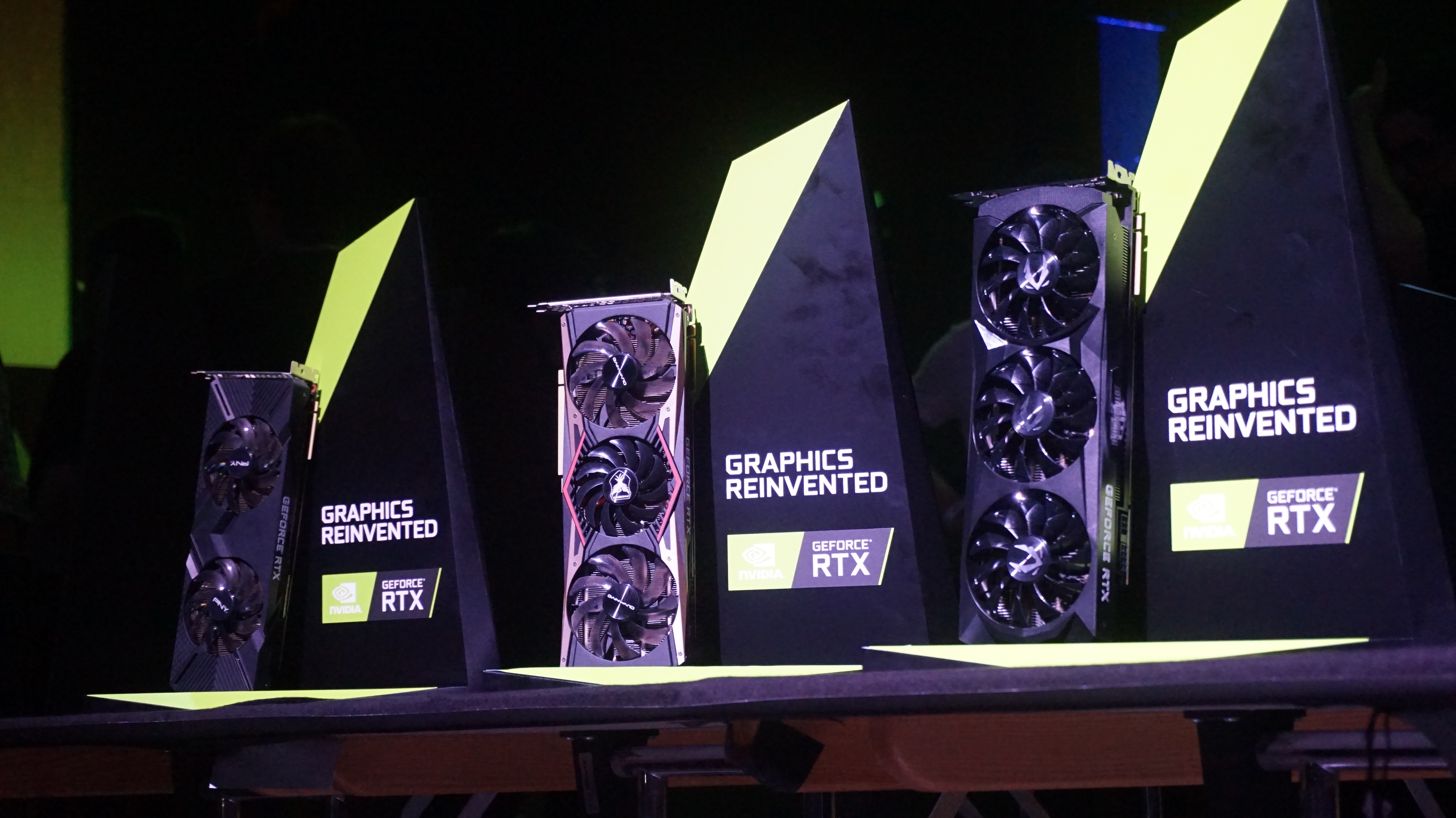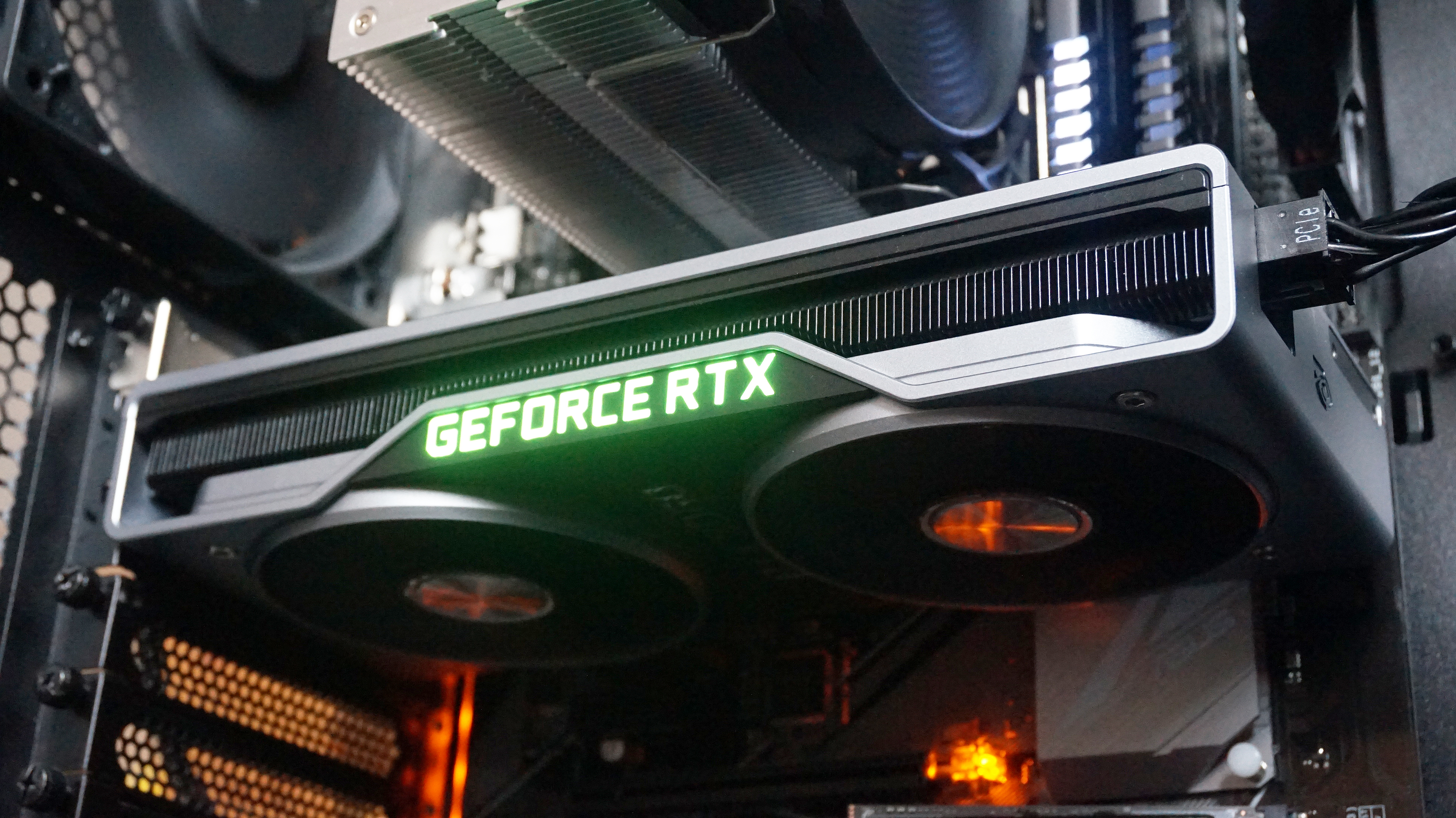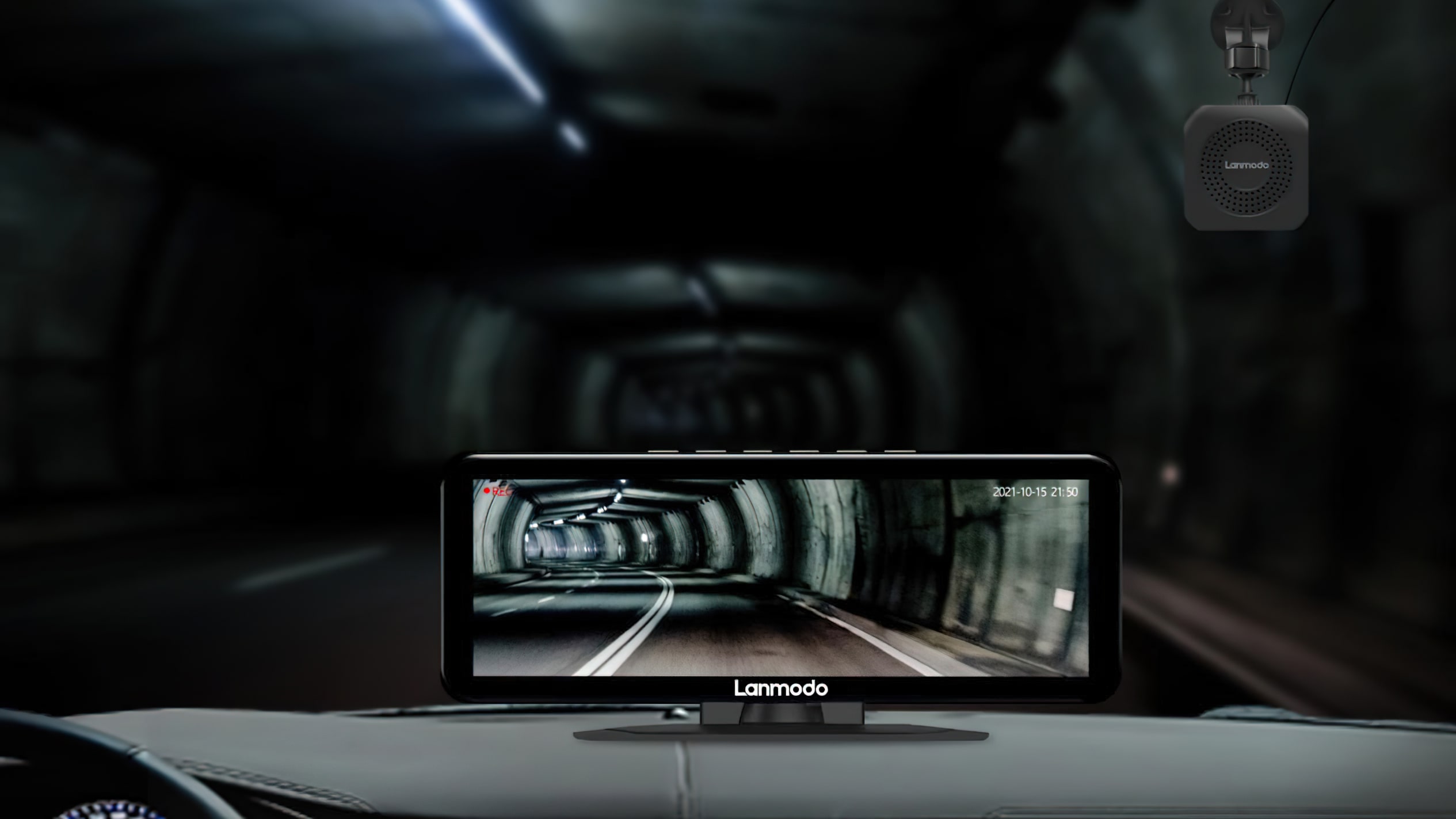
Nvidia’s subsequent era of RTX graphics playing cards are lastly right here, and several other of them have already made their approach into my bestest best graphics card checklist because of their quick efficiency and highly effective new options in comparison with their outgoing GTX counterparts.
But what makes an Nvidia RTX card higher than a daily previous GTX one, and the way do they stack up in comparison with all the pieces else? And what’s all this nonsense about Turing, ray tracing and DLSS? In this information, I reveal all. By the time we’re accomplished right here, you’ll know all the pieces there may be to find out about Nvidia’s RTX playing cards, what ray tracing and DLSS truly imply, and (hopefully) which card you must decide to your subsequent improve. So let’s crack on, lets?
Nvidia RTX: What is it and what does it do?
Nvidia’s RTX playing cards are the corporate’s latest era of graphics playing cards that may steadily succeed and substitute their present crop of GTX graphics playing cards – particularly the GTX 10-series such because the GTX 1060 and the GTX 1080.
As for why these playing cards are referred to as RTX versus common previous GTX, that’s all the way down to their fairly distinctive characteristic set. When Nvidia launched their first pair of RTX playing cards again in August 2018, there was a whole lot of hoo-hah about how their new Turing GPU structure had lastly introduced real-time ray tracing to mainstream graphics playing cards. Powered by the brand new RT Cores (or ray tracing cores) inside their Turing GPUs, ray tracing is – you guessed it – what provides Nvidia’s RTX playing cards their title.
But what does ray tracing truly imply? Essentially, it’s a extremely fancy (and GPU-intensive) kind of reflection expertise that makes in-game gentle behave in precisely the identical approach as we expertise it in real-life. It’s not one thing notably new – Pixar movies have been utilizing this method for years, for instance – however till now it’s been virtually unattainable to realize in games as a result of sheer period of time and computational effort it requires to render while you’re consistently zipping the digicam far and wide. I’ll be going into extra element about what that really seems to be like additional down the web page, however suffice it to say, it’s fairly spectacular stuff.
Ray tracing isn’t the one factor that makes Nvidia’s RTX playing cards particular, although. There’s additionally DLSS, Nvidia’s nifty anti-aliasing / edge-smoothening tech that makes use of Turing’s new AI-driven Tensor Cores and deep-learning know-how to assist increase efficiency at greater resolutions. RTX playing cards are additionally able to one thing often called variable charge shading, too, which lightens the load on the GPU even additional by simulating sure chunks of the atmosphere that don’t require as a lot rendering element, serving to to push body charges greater with no large loss in picture high quality.
The unhealthy information is that purchasing one in every of these new RTX playing cards isn’t out of the blue going to make your games look unbelievable or run at lightning-fast speeds. Instead, a whole lot of Turing’s key characteristic set requires particular assist from particular person builders – and within the case of DLSS, a whole lot of neural community coaching from Nvidia themselves – and proper now there’s solely a fairly small list of games that have definitely been confirmed to be getting some kind of RTX support.
That’s to not say Nvidia’s RTX playing cards aren’t highly effective in their very own proper, in fact, as most of them nonetheless provide an honest step-up from Nvidia’s final era of GTX playing cards. Speaking of which…
Nvidia RTX specs and worth
Below you’ll discover a desk evaluating all of the specs of every Nvidia RTX card that’s been launched to date, in addition to hyperlinks to all our opinions for a extra detailed have a look at their particular person efficiency figures. Just click on the pink hyperlinks and also you’ll be whisked away to their evaluation web page.
| Graphics card | CUDA Cores | GDDR6 RAM | Memory Speed | Memory Bandwidth | Power | Price |
|---|---|---|---|---|---|---|
| Nvidia GeForce RTX 2060 | 1920 | 6GB | 14 Gbps | 336GB/s | 160W | £329 / $349 |
| Nvidia GeForce RTX 2070 | 2304 | 8GB | 14 Gbps | 448GB/s | 175W | £549 / $599 |
| Nvidia GeForce RTX 2080 | 2944 | 8GB | 14 Gbps | 448GB/s | 215W | £749 / $799 |
| Nvidia GeForce RTX 2080Ti | 4352 | 11GB | 14 Gbps | 616GB/s | 250W | £1099 / $1199 |
The solely card we’re actually nonetheless ready on in the mean time is the inevitable RTX 2050 – though in response to current rumours, Nvidia could be ditching their RTX moniker and headline ray tracing assist for his or her next-gen funds card and reverting again to their previous GTX naming conference with the so-called ( and to not point out extremely complicated) GTX 1660. Of course, I’ll replace this with extra right info as and when it’s formally introduced by Nvidia. For now, although, let’s deal with the Nvidia RTX playing cards we do find out about.
In phrases of show outputs, every card can even assist 8K resolutions at 60Hz with HDR enabled – on a single display screen, no much less, because of their DisplayPort 1.4a prepared ports, in addition to 4K at 60Hz through their HDMI 2.0b outputs. They’re additionally able to assist the brand new fancy USB-C tech, VirtualLink. This can be of specific import for VR customers, because it means the cardboard’s USB-C output will be capable to ship all the facility, show and all the information it is advisable to use a VR headset from a single connector.
Nvidia’s additionally hoping their Turing playing cards can be an interesting prospect for streamers, too, as they’ll be capable to encode 8K video at 30fps in HDR in actual time for the primary time, in addition to rise up to 25% bitrate financial savings when encoding with HEVC, and as much as 15% financial savings in H.264. 4K streaming can even turn out to be much more sensible, with Nvidia claiming you’ll get higher efficiency than a typical x264 encoding setting you may be utilizing immediately, with 1% dropped frames when streaming to Twitch at 4K utilizing a 40Ok bitrate, in comparison with 90% through x264, and 1% CPU utilization in comparison with x264’s 73% at 4K over a 40Ok bitrate.
Nvidia RTX efficiency
Specs are all nicely and good, however the important thing query on everybody’s lips is all to do with pace, pace, pace. How a lot sooner are they than Nvidia’s GTX graphics playing cards, and are they price spending all that cash on? In some instances, completely. You’ll discover extra detailed efficiency figures in every RTX graphics card evaluation, however the RTX 2060, for instance, is an astonishingly good graphics card that’s nice worth for cash, and is definitely the equal of Nvidia’s present GTX 1070Ti, providing close to 60fps perfection at 2560×1440 resolutions in addition to completely flawless 60fps+ at 1920×1080 on most high quality settings.
The RTX 2070, then again, is a smidge sooner than the GTX 1080, making it one other nice 1440p card in addition to an honest 4K possibility, whereas the RTX 2080 isn’t actually that significantly better than the GTX 1080Ti – at the very least with regards to uncooked efficiency, that’s, and also you disregard of all its fancy RTX options.
The RTX 2080Ti, in the meantime, is considerably sooner than another graphics card I’ve examined to date, and by far the mightiest card for 4K gaming at 60fps that’s at the moment accessible.
I’ll be doing extra comparability items over the approaching weeks, however for now, right here’s how a whole lot of them stack up towards their GTX competitors.
Nvidia RTX: What the hell is ray tracing and why ought to I care?
As I discussed above, ray tracing is a extremely, actually fancy gentle tech that makes shadows and reflections behave simply how they do in actual life. It’s not correct ray tracing such as you get in Pixar movies, for instance (that’s nonetheless approach past the capabilities of recent GPUs), however Nvidia’s AI boffins have just about given us the subsequent neatest thing – as my interview with Metro Exodus rendering programmer Ben Archard can attest. Have a have a look at Nvidia’s Sol demo to see what I imply:
See how the sunshine displays off each single floor identical to it ought to in actual life, and the way every reflection is able to rendering objects that aren’t even in that exact body? That’s what ray tracing can do, and it’s solely actually while you evaluate games facet by facet that you simply realise how incorrect they seemed earlier than after we didn’t know any higher.
Ray tracing can also be important in creating all these delicate shadow edges that merely aren’t attainable with common lighting methods. Have a have a look at these stills from Mundfish’s upcoming Atomic Heart. You’ll should excuse the standard of my telephone digicam (darkish demo rooms actually aren’t very conducive to good picture-taking), however the distinction is like evening and day.
- Soft shadows, correct mirror reflections…
- Hard shadows, who is aware of what mirror reflections…
- Other objects from across the room are clearly seen on this glass tank…
- But disabling ray tracing means there aren’t any reflections to talk of in any respect.
At the second, there are only a handful of confirmed RTX games that can be supporting Nvidia’s ray tracing tech, however the demos I’ve seen to date have all been fairly tasty-looking, from Shadow of the Tomb Raider’s energetic Day of the Dead scene to Battlefield V’s exploding tank fireplace within the eyes of your enemies.
The unhealthy information, but once more, is that ray tracing nonetheless takes a large toll on the previous efficiency ranges. While I’ve but to place Battlefield V by its paces, the Metro Exodus team said they were aiming for 60fps at just 1080p with all of its ray tracing tech turned on once I spoke to them again in August, suggesting you’ll want one of many higher-end Nvidia RTX playing cards to essentially profit from it.
Fortunately, Nvidia are working arduous to make sure that Turing’s different key characteristic may help decide up the slack. Enter DLSS.
Nvidia RTX DLSS: Turing’s secret weapon
Fortunately, Nvidia’s crammed a whole lot of different performance-boosting bits of AI tech inside their RTX playing cards that may hopefully negate any potential ray tracing influence if builders reap the benefits of them. Indeed, for all the eye given to ray tracing throughout Nvidia’s RTX launch, it isn’t practically as attention-grabbing as Turing’s different key characteristic, DLSS.
Also often called Deep Learning Super Sampling, this little bit of tech is fairly rattling neat. In essence, it’s an excellent environment friendly type of anti-aliasing (AA) and makes use of Turing’s AI and deep-learning-stuffed Tensor Cores to assist take a number of the pressure off the GPU. AA, in case you’re unfamiliar with the time period, is a method game makers use to make strains and edges seem clean and pure as a substitute of 1,000,000 jagged pixels.

Once Turing’s AI smarts have been educated with a particular neural community devoted that exact game (on this case, Epic’s taxing Infiltrator demo), DLSS games gained’t simply produce a extra correct image, however they’ll additionally purchase you additional frames within the course of (click on to enlarge).
It’s notably necessary when taking part in games at 4K, as extra widespread AA methods, equivalent to temporal anti-aliasing (TAA), can usually soften pictures a bit an excessive amount of (negating that pretty sharp feeling 4K ought to convey) in addition to get issues a bit incorrect when scenes are taking place at pace. Whether you’ll discover any of this with out the help of a freeze-frame digicam gadget, in fact, is up for debate.
The key factor is that it may possibly actually assist pump up these body charge figures with out a lot of a dip in picture high quality. It’s solely accessible in Final Fantasy XV in the mean time, however right here I discovered I used to be in a position to get round another 10-15fps out of it with DLSS turned on in comparison with the game’s default AA choices.
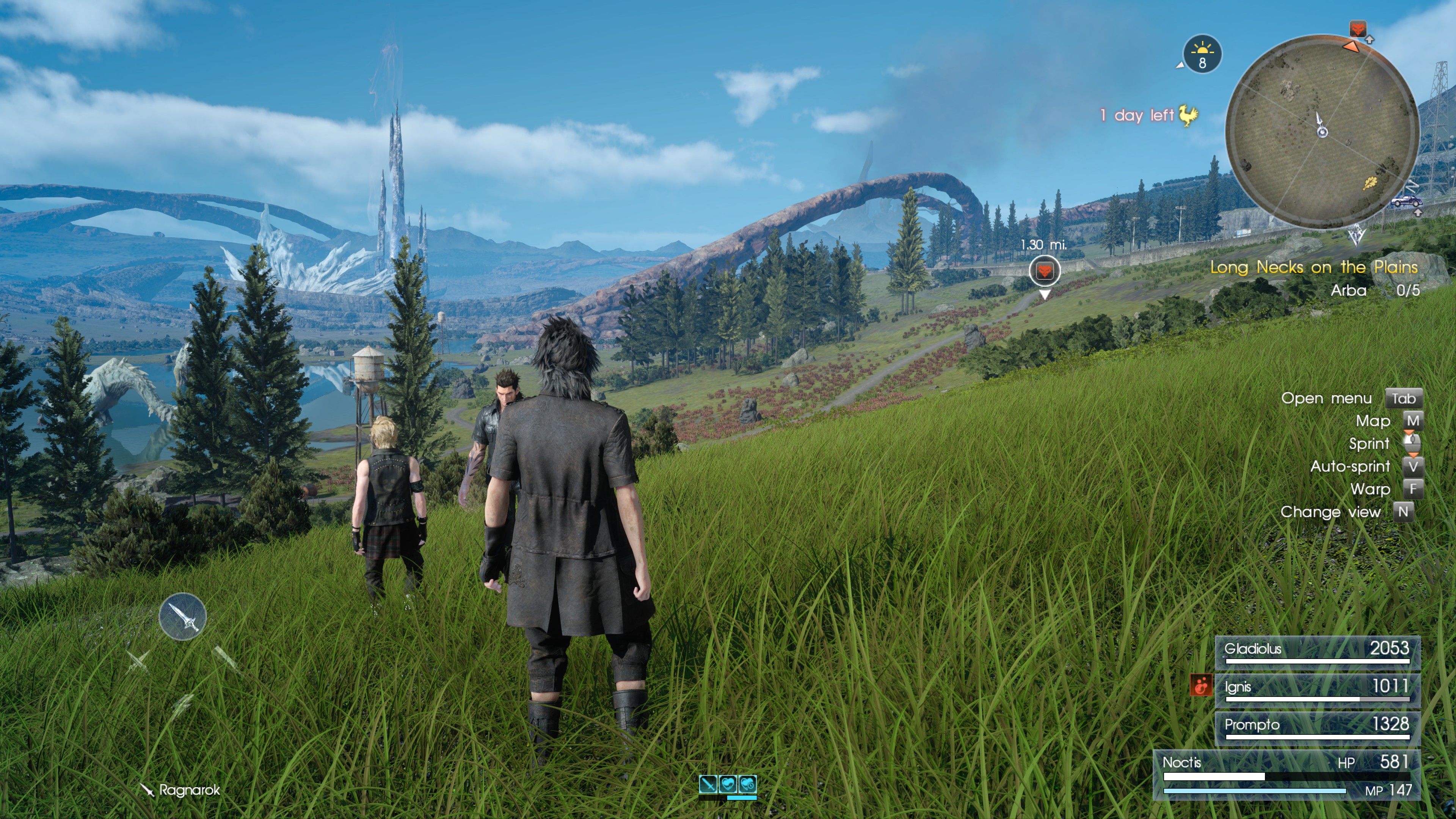
…and right here’s what the game seems to be like with no DLSS on Highest at 4K (click on to enlarge)
Much like ray tracing, nevertheless, DLSS is a separate characteristic that not solely must have supported added by particular person builders, however a hefty little bit of enter from Nvidia themselves as nicely, as they’re those that want to coach their intelligent AI neural community boffin machines on every game within the first place to verify they’re predicting (and due to this fact producing) the right textures and pictures. Only as soon as this course of has been accomplished can DLSS assist be enabled by builders.
Still, from what I’ve seen of DLSS to date, it’s an extremely spectacular little bit of tech that, if there’s sufficient uptake, ought to give Nvidia’s RTX playing cards a large benefit over no matter happening with AMD’s Navi next-gen GPUs – particularly if it may possibly make up for the efficiency dip introduced on by all that ray tracing malarky.
Nvidia RTX: Variable charge shading
Last however not least, variable charge shading is one other intelligent little bit of AI tech in Nvidia’s RTX playing cards that may present one other efficiency increase to assist maintain these body charges good and excessive. It does this by concentrating the element of a scene the place it’s wanted most (within the centre, say, the place you’re focusing most of your consideration), and lowering the extent of element elsewhere, equivalent to issues on the periphery or easier bits of geometry within the foreground.
To give an instance, think about a scene from Forza Horizon 4. The automobile’s within the center, you’ve acquired that fantastic British countryside stretching out in entrance of you, fields whizzing by to your proper and left, and the remainder of the street trailing behind you.
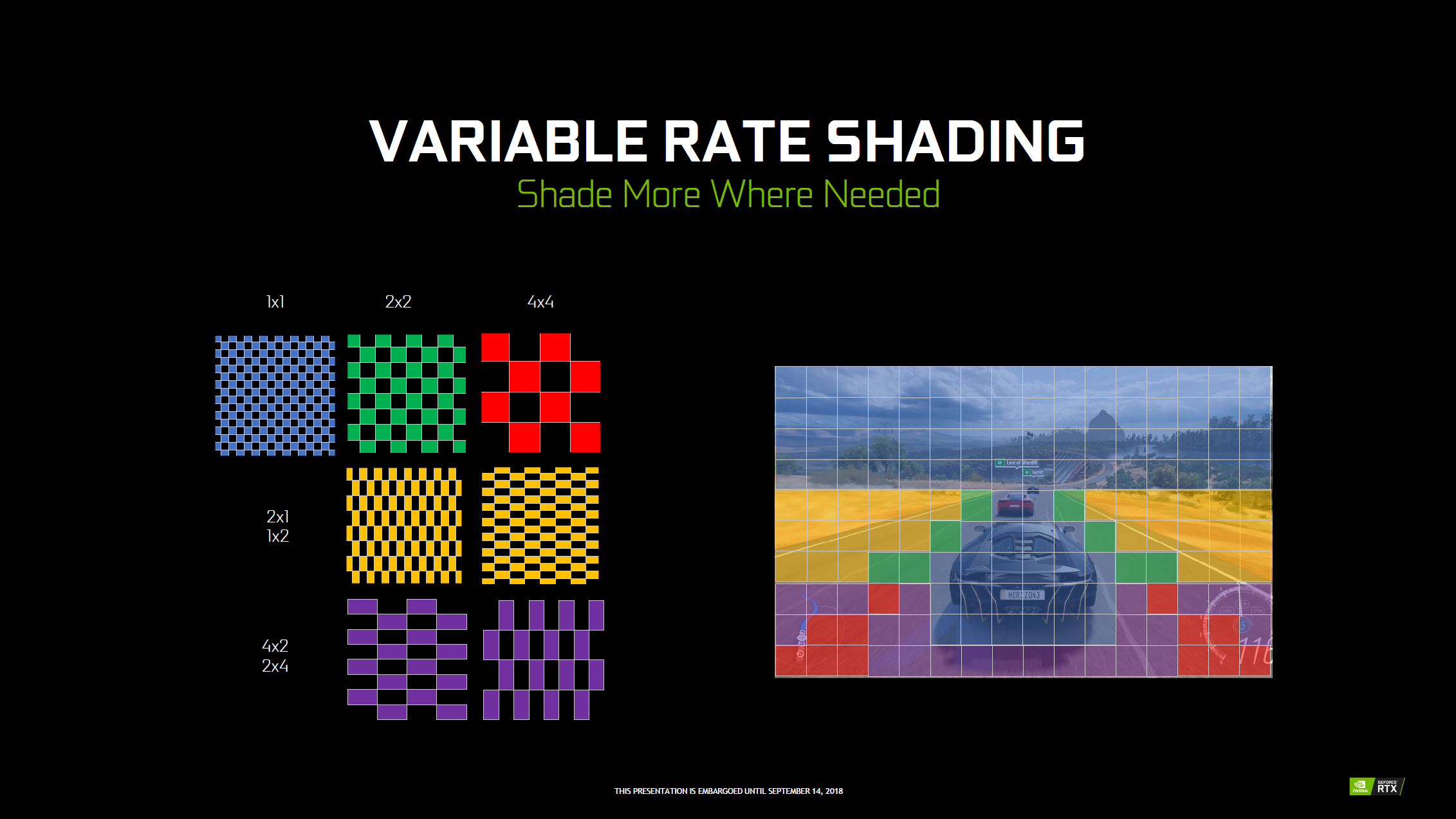
The blue sections require essentially the most element, however the purple and pink areas of the scene are much less necessary, so Turing can shade them at a decrease charge on the fly to get extra efficiency.
Naturally, the automobile and horizon are the primary focus of your consideration, so these bits can be given essentially the most element. The fields to the facet are much less necessary, so they may have half as a lot shading given to them. The street, in the meantime, is unquestionably not the place your consideration ought to be targeted on this high-octane racer, so that may obtain half as a lot element once more. The finish result’s a scene that not solely seems to be good and sharp the place it counts, however delivers the next body charge than if all the pieces was being rendered with the identical quantity of element.
If you’re fearful that this would possibly make games look a bit inconsistent, worry not. Another instance Nvidia confirmed me at Gamescom was the submarine space from Wolfenstein II: The New Colossus. Here, variable charge shading was getting used to intelligently assess which bits of the scene to shade correctly with out a lack of general high quality.

I performed a reside demo of this tech at Gamescom utilizing the identical scene in Wolfenstein II, and I couldn’t spot the distinction there both.
Technically referred to as ‘content adaptive shading’, this was arguably one of the spectacular demos I noticed throughout Nvidia’s complete presentation, and the distinction between having it on and off was nearly imperceptible. There was a imprecise type of rippling impact current once I was standing inventory nonetheless surveying the centre of the primary management room, however it utterly disappeared the second I began to maneuver. What’s extra, the body charge leapt by 15-20fps once I had it turned on, which is fairly spectacular for nigh-on equivalent picture high quality.
Nvidia RTX conclusion: Is it price it?
There’s no denying that Nvidia’s RTX tech is spectacular stuff. Every demo I’ve seen confirms it, as does what I’ve performed and examined in precise games as nicely. The drawback is that there are nonetheless far too few games that really assist ray tracing and / or DLSS to make it price upgrading to one in every of Nvidia’s RTX playing cards on these grounds alone. At time of writing, Battlefield V and Final Fantasy XV are the one games which have truly had their RTX assist added in to date, and there’s at the moment no phrase on when it’s going to arrive for different already-released games equivalent to Shadow of the Tomb Raider, or whether or not it is going to be prepared in time for upcoming blockbusters equivalent to Metro Exodus.
Then once more, I believe it’s additionally honest to say that ray tracing and DLSS don’t appear to be simply passing fads for this specific era of graphics playing cards, and I’d be very stunned certainly if assist for Nvidia’s RTX tech didn’t proceed to develop and turn out to be extra widespread because the months and years roll on.
Until that occurs, although, the one actual cause to improve to an Nvidia RTX card proper now is the essential efficiency increase they provide over their GTX predecessors, which is extra compelling on some playing cards than it’s on others. The RTX 2060 is unquestionably one of many higher worth RTX playing cards in the mean time, however these in search of one thing even cheaper would do nicely to carry on a bit bit longer till we see what’s taking place with this so-called GTX 1660, which nonetheless has a Turing-based GPU, in response to the newest gossip from the hearsay mill, however no ray tracing assist.

